#hot take steamed peanuts > fried peanuts
Text
What Arch Ate
Heya folks, Arch here, back with another instalment of this little ongoing series! Seeing as I foolishly forgot to put one of these together last week, this week's WAA is a two-for-one special!
Today, I'd like to bring to you all Nasi Lemak, and Tau Suan.
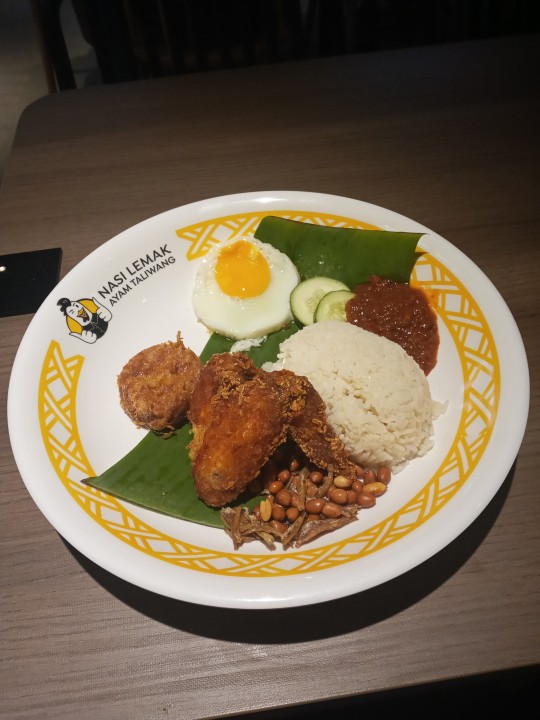

On the left and right respectively. Had both of these in the same day, the former for lunch at a food court, and bought the latter home as one of my favourite desserts.
And here are some significantly better pictures!
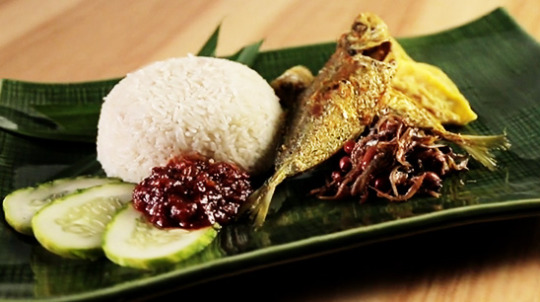
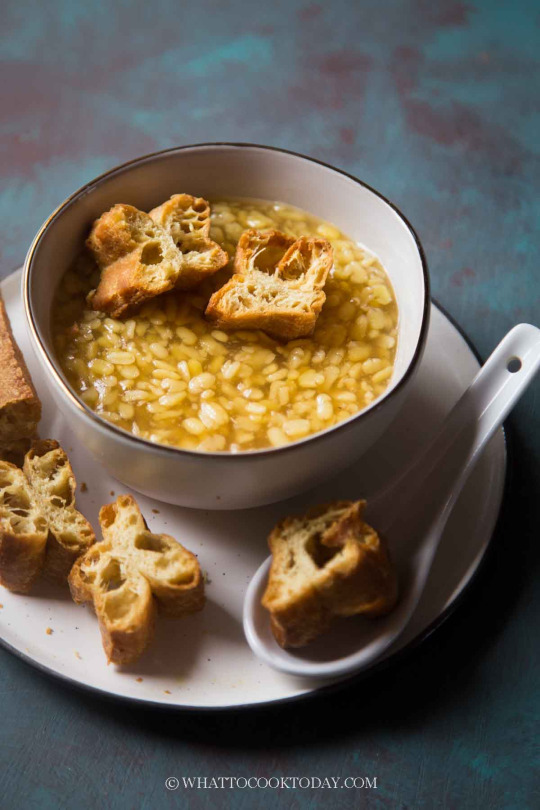
------
Nasi Lemak, which directly translates to 'fat rice', is a Malay dish popular pretty much everywhere in Southeast Asia with a significant Malay population, which very much includes Singapore. That name comes from the way the 'Nasi' is cooked, being soaked in coconut milk before being steamed, often with pandan leaves and other aromatics for extra flavour. The result is a 'creamy' and rich rice, which is served in numerous ways with various dishes. Those commonly include a mixture of roasted peanuts and ikan bilis (fried anchovies), sambal (a spicy chili 'paste'), and cucumbers, as well as various proteins ranging from fried fish or chicken to eggs.
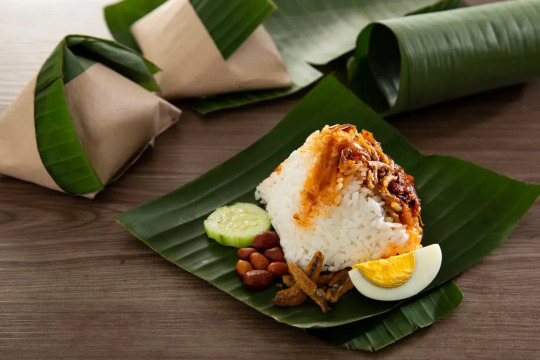
One notable feature I'd like to point out has to do with how Nasi Lemak can be served. While 'on a plate' is common enough in most places, as part of the dish's past as a 'working breakfast' of sorts, it has long been served wrapped in banana leaves, forming a pyramid covered in brown waxed paper which can be brought along with you. As a result, it's not uncommon for Nasi Lemak to be served on or with a banana leaf, as in all the above pictures, regardless if you're using a plate or not.
------
While Nasi Lemak is a meal in itself, Tau Suan very much isn't. Instead, this Chinese-originated dish is a dessert, though pretty different from what you might expect from that term in the 'West'.
This dish is made with mung beans, and takes the form of a starchy, sweet syrup or soup, best served hot. It's commonly eaten with You Tiao, long sticks of fried dough cut up into bite-sized pieces and allowed to soak in the syrup. A personal favourite dish of mine, and has been since I was a kid!
Tagging @athensoddcollections @theprissythumbelina (and, if you don't mind, @caxycreations ! Will stop if you'd like me to, of course.)
6 notes
·
View notes
Text
My cooking repetoire (started cooking with much trepidation 2 years ago) Nothing takes more than 5 minutes and most recipes are made up by me or a friend. Tiff most commonly. 99% of ingredients from Trader Joe's
Scrambled eggs with ketchup, spinach, Kewpie mayo and cajun seasoning
"Chicken n' waffles Tempeh" (Tempeh + Mirin)
Shakshouka
Salmon burgers with tartar sauce or truffle aioli
Eggplant or leeks with soy sauce, cumin and garlic
From the package Japanese Golden vegetable curry with vegetables
Roasted vegetables (brussel sprouts, asparagus, cauliflower or broccoli usually)
Ray Peat Macrobiotic Carrot Salad
Homemade peanut salad dressing on cabbage
Steamed bok choy with homemade "strange flavor sauce"
Farrow with fried onion, fried egg, and hot sauce (kinda odd)
Shirred Eggs
Bean salad with black beans or chick peas, onion, garlic, lemon juice, parmesan cheese, cucumber, peppers
Sushi rice, japanese sweet potato, sauerkraut and ponzu sauce
Fried polenta with pesto or mozzarella and tomato
Beets, goat cheese and lentil salad
Avacado toast with everything bagel seasoning for crunch
Fish collagen chocolate pudding
The corn syrup squash which was a rare miss
6 notes
·
View notes
Note
my favorite way to prepare cauliflower is sauteed in a high-heat-friendly neutral oil (canola<3), with turmeric, black pepper, cumin, paprika, chile powder, a few drops of dark soy sauce and like 8 grains of dark brown sugar. it's so incredibly delicious on its own or as a side to basically anything, or throw some small white potato chunks and chickepas in the pan too and serve it as a main course
my favorite way to prepare napa cabbage and similar is to cut off the tips of the leaves, wash and lightly salt them, let them sit for the time it takes to make an instant pack of spicy kimchi ramen, drain the liquid from the cabbage, then pour the hot ramen broth over them (serve in the same bowl as the ramen!). the broth will cook it slightly without making it lose crunch, and it's light and refreshing to bite into it while you enjoy your noodles
my favorite way to prepare king oyster mushrooms is to cut them into strips (or just use seafood/enoki mushrooms whole instead), saute with butter, light and dark soy sauce, lime juice, and an eensy bit of hot sauce. when theyre cooked, serve them as the main flavor component in sushi or spring rolls, with carrot and/or cabbage and/or tofu and/or red bell pepper and/or salmon etc. delicious!!!!
my favorite way to prepare kale is to massage it (with a dash of rice vinegar if you want) until it becomes softer and slightly brighter green, then serve as the base of a salad with fried tofu or tempeh, steamed sweet potatoes, a scoop of cooked brown rice or farro, cucumber slices, and a thin peanut sauce
omg :’) this is so sweet, i am delighted. i am 100% trying these, ESPECIALLY king oyster in sushi, that sounds amazing. the tip about napa cabbage in ramen is excellent too. thank u so much for sharing with me 🥬💚🥬💞
3 notes
·
View notes
Video
youtube
Stir-fried Sticky Rice Recipe (生炒糯米飯) with Papa Fung, December 23, 2022
An aromatic sticky fried rice loaded with Chinese sausage, dried shrimp, shiitake mushrooms, green onions and some cilantro. The sticky texture is what makes this rice dish stand out. A great crowd pleaser for pot lucks!
Stir-fried Sticky Rice Recipe [生炒糯米飯食譜]
This recipe makes 4 bowls of pan-fried sticky rice [製成四碗]
Ingredients [食材]
500 g glutinous rice [糯米]
2 Chinese sausages [臘腸]
5 shiitake mushrooms [冬菰]
30 g dried shrimp [蝦米]
60 g peanuts [花生]
1 tsp lard [豬油]
A few stalks of green onion [青蔥]
1 stalk cilantro [芫茜]
2 tbsp oyster sauce [蠔油]
8 g sugar [糖]
5 g salt [鹽]
Some white pepper [胡椒粉]
Some sesame oil [麻油]
(250 ml mushroom/shrimp water) [浸冬菰和蝦米水]
Directions [製作]
Soak glutinous rice for 4 hours. Strain and set aside. [糯米浸四小時,瀝乾備用。]
Wash shiitake mushrooms and dried shrimp. Soak until softened. Keep the mushroom and shrimp water for frying the rice later. [冬菰和蝦米先洗乾淨,再軟取出備用,留起水用作炒飯。]
Dice all the ingredients, set aside. [將所有材料切碎備用。]
Melt salt and sugar with hot water, mix until combined. Add in sesame oil, white pepper and oyster sauce, mix and set aside. [鹽和糖先用熱水攪溶,再混合蠔油,胡椒粉和麻油置一旁。]
Roast some peanuts until fragrant, set aside to cool. [白鑊炒熟花生備用。]
Heat up wok, melt lard, stir fry Chinese sausage until cooked, add in shrimp and cook, add in mushrooms, cook until fragrant. [熱鑊放豬油加入臘腸炒熟,再加蝦米炒香,再加冬菰炒至有香味。]
Add in rice, continuously stir and add shrimp/mushroom water a little bit at a time and cook with the lid on to speed up the process. Once the shrimp/mushroom water has evaporated, repeat until the rice is fully cooked. [加入米要不停翻炒,同時加些少蝦米水及加蓋焗至水份收乾,重覆以上步驟至飯熟。]
Once rice is cooked it’ll become sticky, now, mix in sauce that was prepared earlier. [當飯有黏性加入調味料炒勻。]
Lastly, add in some dark soy sauce for some colour, and cilantro and green onions, and mix until combined. [最後加些少老抽調色和加芫茜和青蔥炒勻即可。]
Place some cilantro and peanuts into the bowl, followed by the rice, flip bowl to reveal the dish and serve. [放芫茜和花生入碗內,加上糯米飯,倒扣在碟上即食。]
***
The twelfth lunar month is called laap yut (臘月), the cold and dry weather being appropriate for drying and curing. Some recipes call for cured pork belly (laap yuk, 臘肉), cured belly to go with the (Southern) Chinese sausage (laap cheung, 臘腸) which are traditional season staples. Lard and sources of it were a year-round necessity for oil, fuel, flavouring, and caloric density but particularly important during lean months like the height of winter. Most of the ingredients for stir-fried sticky rice are dry or stable preserved goods that balance out the strong and rich pork and lard.
I made a batch Thursday for the winter solstice (Dongzhi, 冬至) using a different recipe. Like a lot of seasonal and festive foods the idea remains the same while the specifics change, and there may be something new for me to adopt from this version.
My mom used to use a rice cooker to steam the glutinous rice keeping it on the firm side, combining everything in the wok at the end. While soaking then stir-frying the rice from raw to cooked (as the name of the dish states) isn’t actually too bad adjusting for the size of wok or pan but it does take time and practice. I’ve taken to seasoning the soaked and drained rice by mixing it with a bit of oil and salt in a bowl while preparing everything else. The added oil from stir-frying seems to need a heavier hand with seasoning (like oyster sauce, added salt, or soy sauce) than with steaming the rice.
After soaking, squeezing out most of the excess water, and dicing the mushrooms, she always marinated them with some oil, light soy sauce, and sugar. There was also soaked and shredded dried scallop (conpoy or gong yiu chyu, 乾貝 / 江瑤柱) in addition to the small, dried shrimp when we had some.
One thing glossed over in the video is that the water can have sediment at the bottom; the initial washing leaves sand and grit that is released after rehydrating and should be discarded. This cold broth from soaking the dried ingredients adds to the savouriness of the rice along with the sausage and lard. The added oyster sauce in this and other recipes boosts the concentrated seafood accent. In the rice cooker/steamed rice version, the broth can be used to cook and soften the stir-fried sausage, mushrooms, and dried seafood, covering and reducing it fully before adding the rice.
A quality dark soy sauce is often enough to colour and flavour the fried rice. The addition of white pepper and sesame oil to the sauce for the rice is new to me, though I imagine it cuts through the pungency of fat and the concentrated seafood and reducing the additional lard needed.
Peanuts, cilantro, and green onion are not essential, though they do add to the texture and freshness when the overall dish can be heavy. These are often garnishes added last as it is often reheated, softening the peanuts and the greens darken while losing flavour and crispness. Less and less restaurants bother with the peanuts at all: they become hard especially if fried or roasted and stale while others overcook the peanuts by boiling or with steam becoming bulk rather than texture. It’s easy to see why peanuts could be cut from an already long list of ingredients. One local dim sum has replaced them with what I’m certain is rendered pork rinds for a sturdier crunch. There’s probably an element of adapting it with more sensitivity towards peanut allergies, while at home we never had them as a staple.
Another common addition to improve the overall dark colour is thinly-chopped omelette or a fine scramble. It was fashionable for a time at some restaurants to wrap it omurice-style or reheat portions with rehydrated lotus leaves to impart a different scent. Some recipes use a long grained glutinous rice or cut it with white rice to soften the chew but in the wrong proportion it compromises the structure and ability to keep or reheat. There was a decade where places would just steam portions in the bowl upright and uncovered resulting in a soggy fried rice.
Turning the rice out moulded with a bowl is solid, old-school presentation, it demonstrates how well the rice is made: sticky enough to hold a shape even when portioned; the thorough and even mix of ingredients, colour, and flavouring without overworking; and a careful stir-fry that is oiled enough to release. A good fried rice, sticky or otherwise, needs a shine without being greasy.
#food#Chinese#冬至#seasons#time#winter#cooking#生炒糯米飯#臘月#Papa Fung's Kitchen#Dongzhi Festival#real life#notes
5 notes
·
View notes
Text
Southeast Asian Cuisine: Culinary Delights
Let’s go on a journey through Southeast Asian Cuisine, where each dish tells a story of tradition and flavor. This guide unveils the culinary treasures of Vietnam, Thailand, Indonesia, and beyond. Southeast Asia serves hundreds of culinary delights for those wanting to try new foods and experience different tastes. Exploring the diverse cuisine in Southeast Asia allows people to better understand the history and people of the region. So, if you’re considering visiting the area any time soon, there are certain dishes you certainly will want to take advantage of! Let’s jump in and look at the highlights of some of the essential dishes in the region.
A Foodie’s Journey Through Southeast Asian Cuisine
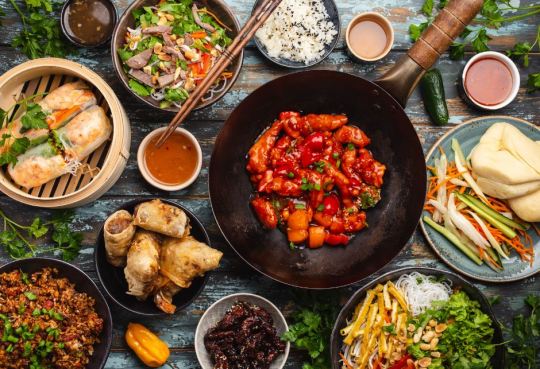
Indonesia
Indonesian cuisine is less famous than other regions like Thailand or China internationally (a situation the Economist attributes to varying factors like politics and prejudice). But there are incredible dishes using rich, flavorful ingredients and spices. An Indonesian staple is rice. It may be served steamed, slightly cooked, or wrapped in leaves. Other popular foods include soup, noodles, and dishes like Nasi Goreng and Rendang.

Rendang is a traditional Indonesian dish originating from Padang. It consists of tenderized beef marinated in coconut milk and traditional species. It certainly is a favorite among people visiting the region. Other notable mentions include satay lilit in Bali. This is a grilled minced meat dish seasoned with chili, lime, and lemongrass. Siomay, a street snack consisting of fish dumplings, sliced potatoes, cabbage, and tofu, topped with a tasty peanut sauce is also great.
The Philippines
Filipino cuisine is more like a fusion of various cultures and influences from Malay, China, and Spain. Some of the more popular choices for those visiting the region include Lechon (roast pig), a staple in Cebu. Don’t miss out on chicken inasal (a charcoal-grilled chicken dish). If you have the chance, enjoy the authentic version in Bacolod. Other tasty meals include adobo (which is marinated meat), and morcon (made from beef, poor, sausages, onions and eggs).

If you’re visiting Davao, take advantage of the opportunities to try durian. There’s also numerous varieties of durian fruit (consisting of candies, cake, flavored coffee, and more). If you are looking for a new taste sensation, the Philippines is definitely the right choice for you.
Southeast Asian Cuisine – Thailand
The history of Thai food interweaves ingredients and cooking methods from various cultures. The result is a culinary experience that attracts people from around the world. If you’re looking to participate in it, Thai street food is a perfect choice. While visiting, definitely don’t miss out on the roadside stalls where you can try out some delicious options like moo ping (grilled pork), tom yum goong (hot and sour shrimp), Khao man gai (chicken and rice), Khao niao mamuang (sticky rice), grilled skewers and Pad Thai. Head out early in the morning if you want a comforting bowl of jok, a rice porridge featuring pork topped with ginger and onions. Street food allows for a truly immersive experience for those visiting Thailand and wanting to get a unique taste of their culture.

If you want to explore Thailand, remember that each city and region features something unique. In Chiang Mai, stop and enjoy Khao Soi, a curry soup made with coconut milk served over egg noodles and topped with layered crispy fried noodles. Heading to Northeastern Thailand? Try Som Tam, a mash of tasty vegetables, Larb, and Nam Toke, and salads of meat, rice, lime, and fish sauce. Staying in the central region of Thailand? Well, many describe Bangkok as a “”food lover’s paradise, ” so don’t miss out on everything the city has to offer. If you’re heading South to the beautiful islands, try Sataw (prawns with a unique flavor), Massaman curry, or Khua Kling.
Vietnam
Southeast Asian Cuisine and Vietnam! If you’re traveling in Vietnam, you’ll encounter a range of dishes and flavors that change from North to South. Those in Sagon enjoy bánh xèo (crispy pancakes) rolled with greens and dipped in sweet-and-sour fish sauce, while Hai An Cao Lau noodles are a popular snack. Don’t miss out on the fantastic street food options like banh mi (a sandwich featuring pickled vegetables, fresh cilantro, pork belly, pork floss, and cucumber) or pho (featuring flat rice noodles with beef or chicken cooked in a hearty stock, spiced with clove, and cinnamon and anise).

Bánh Xèo, emerging from the Mekong Delta and popular in south and central Vietnam, features a batter made from coconut milk and rice. The filling contains pork, bean sprouts, and shrimp. If you still have room, try Che, a dessert sometimes served hot or cold and topped with fruits like bananas and longan. The unique combination of sauces, herbs, and spices creates a memorable experience that captures Vietnamese cuisine.
Singapore
We have to talk about Singapore if we are talking about Southeast Asian Cuisine. Singapore’s cuisine combines influences from China, Malay, and India. Some staples include Hainanese chicken rice and chili crab. Suppose you’re looking to check out some fine dining. In that case, several Michelin-star regional restaurants offer a promising taste sensation.

Laos
Laos’ amazing scenery and deep cultural legacy makes it a popular choice. The food is also worth trying out. Laotian cuisine is not as well known in the West. The dishes may seem simple, but it’s quite flavorful, frequently combining fermented pork and fish with chilies and fresh herbs (think mint, cilantro, makrut lime leaf, ginger, garlic, etc.).

Cambodia
When we talk about Southeast Asian Cuisine, we have to talk about Cambodia. The use of different herbs and spices, together with the addition of tropical fruits from the area, define the cuisine. The region’s most popular dishes include lok lak, a stir-fried beef dish; fish amok, which is fish made with banana leaves; and amok, a stew made with kroeung and fresh coconut milk. The cuisine of the area combines a variety of tastes, from spicy to sweet, to produce a flavor profile that is sure to please. You might want to try kangkep baob if you’re feeling more daring. It’s a frog that’s been roasted over hot coals packed with peanuts, chiles, pork, and different spices like garlic and lemongrass.

Southeast Asian Cuisine: A Feast for Foodies
Southeast Asian Cuisine is delicious. Whether you want to visit the numerous street vendors or immerse yourself in an exciting culinary experience by visiting a more upscale restaurant, you will be very content with Southeast Asian food. There are an infinite variety of flavors and dishes worth exploring. Hopefully, this article has pointed you toward some of the more popular ones you wouldn’t wouldn’t-would want to take advantage of. Also, please check my other article on Discovering the Wonders of Southeast Asia Travel: A Comprehensive Travel Guide.
And as always, don’t forget to follow to be in the loop. 👍
#travel and tourism#travel guide#travel blog#travel diary#places to explore#travel goals#travel destinations#southeast asia#southeastasia#southeast asia travel#southeast asian food#southeast asian cuisine#philippines#thailand travel guide#thailand#phuket#asia#vacations#thailand tourism#vietnam#travel#places to visit#malaysia#indonesia#bali#in view adventures#laos#cambodia#asian food#lechon
1 note
·
View note
Text
Best and Worst Thai Dishes for Your Health
Best: Summer Rolls
At less than 140 calories every, this tidbit won't indulge your supper. Summer rolls highlight a variety of veggies, including lettuce, carrots, and cucumber, alongside noodles and shrimp. That is undeniably enveloped by a rice-paper skin. Have one roll and skirt the plunging sauce, which attaches additional sodium and sugar. Can't track down them on the menu? They're additionally called crisp spring rolls. Looking for the best Thai restaurant in Dubai Visit this link.
Most obviously awful: Broiled Spring Rolls
Of course, they're loaded up with cabbage and carrots, yet those veggies are full into a flour covering, then rotisserie in oil. The outcome: Every little roll can pack in approximately 130 calories and 6 grams of fat. Furthermore, that does exclude the sweet plunging sauce. Finish a request for four, and you'll take in a whole feast of calories.
Best: Papaya Salad
Begin your dinner with a serving of foods grown from the ground. The primary fixing in this salad is fresh green, or unripe, papaya. One cup presents 3 grams of fiber and an overabundance in a day. This destroyed natural product is thrown with green beans and tomatoes. Peanuts are mashed, alongside protein and heart-solid unsaturated fat.
Most horrendously terrible: Thai Broiled Rice
This rice doesn't have a lot of fiber, and that can leave you feeling drained and hungry. Request the steamed earthy colored rice all things being equal. Research shows that eating a lot of entire grains, like earthy-colored rice, can bring down your possibility of type 2 diabetes, coronary illness, and disease.
Best: Chicken Satay
Satays are sticks of barbecued, marinated meat. Settle on the chicken, and you'll score a low-fat dish that is high in protein. That can assist with battling off yearning and set up for weight reduction. Satays are typically presented with a zesty sweet nut sauce. Rather than dunking each stick, put a little on your plate. Two tablespoons of the sauce present 80 calories and almost 10% of all the sodium you ought to get in a day.
Most awful: Red or Green Curry
Thai curries are generally made with a strong portion of coconut milk, and that will not help your eating regimen. One cup of the smooth milk packs in 400 calories. It additionally has 36 grams of immersed fat - - multiple times the suggested everyday sum. For a better dish, request the barbecued or grilled curry chicken.
Best: Tom Yum Soup
The scoop on this hot-and-sharp soup? It's a sound pick. Tom Yum has less than 100 calories for each cup. It additionally has shrimp, veggies, and fragrant flavors, like lemongrass. Tom yum and other stock-based soups, similar to tofu-vegetable or wonton, are generally lower in fat and calories than soups made with coconut milk, for example, tom kha.
Most awful: Massaman Curry
Like its red and green partners, Massaman Curry gets its smoothness from coconut milk. Be that as it may, this adaptation is made with peanuts and potatoes, so it's not unexpectedly high in calories. One cup can have a bigger number of calories than a cheeseburger and fries - - and two times as much fat. Furthermore, that does exclude the side of rice that accompanies it.
Best: Chicken Larb
It could be a plate of mixed greens, however this dish can be a delightful dinner. It's made with protein-loaded minced chicken with cilantro, mint, onions, and bean stew peppers. And all that is thrown in a lime juice dressing. Larb is frequently presented with tacky white rice and lettuce. Utilize the lettuce leaves as salad cups, and you'll get additional heart-sound vitamin K. Yet, avoid the rice; it attaches additional calories without adding a lot of nourishment.
Best: Cushion Thai
This dish is a menu staple of Thai eateries. It's produced using rice noodles sauteed with flavors, peanuts, egg, and bean sprouts. Get it with shrimp, chicken, or tofu for lean protein, and additional veggies for fiber and nutrients. Simply watch your part: Cushion Thai gets started at 300 to 400 calories a cup. A few eateries' dishes are three or multiple times that.
Most terrible: Thai Chilled Tea
This drink gets its pleasantness from sugar and consolidated milk. The outcome: a 16-ounce serving that can pack in additional calories and sugar than some frozen yogurt. On the off chance that you're in the mindset for tea, request a glass of the unsweetened kind. Alongside the invigorating flavor, you'll likewise get well-being support. Both dark and green tea have illness-battling cancer prevention agents.
Best: Pan-sears
These frequently pair protein with veggies, similar to tofu with broccoli or basil chicken with string beans. That implies you'll get nutrients and minerals, alongside protein to remain fulfilled. Request the dish with earthy-colored rice rather than white, and you'll get an additional 2 grams of fiber for every half-cup of rice. Since the sauce as a rule has sodium, fat, and sugar, request it as an afterthought.
Most horrendously terrible: Fresh Fish
In the mindset for fish? Avoid "fresh" or "broiled" dishes. That is code for broiled in oil, and that implies it has additional fat and calories. One investigation discovered that individuals who ate broiled fish at least a couple of times seven days were 44% bound to suffer a heart attack, contrasted and the people who had it not exactly one time per month. Help your well-being out and arrange your fish steamed, heated, or cooked all things being equal.
Best: Wilderness Curry
Most Thai curries are made with velvety coconut milk, however, this one uses water, stock, or stock, so it's lower in calories and fat. Request the tofu, chicken, or fish adaptation with earthy-colored rice for additional fiber. On the off chance that you can deal with the intensity, get it fiery. A compound in stew peppers called capsaicin might assist with safeguarding you against malignant growth and coronary illness.
Most horrendously awful: Seared Bananas
A natural product pastry is solid, correct? Not dependably. This rendition, called "gluey keg," takes banana cuts and plunges them into a sweet coconut hitter. Then, at that point, they're broiled in oil. On the off chance that you're in the mindset for something sweet, go with the natural product sorbet or tacky rice all things being equal. While those treats have added sugar, they're lower in fat than broiled bananas.
0 notes
Text
Looking for Chinese Food in San Diego: Shanghai Bun
The culinary scene of San Diego is well known for being thriving and diverse. One of the most popular cuisines in San Diego is Chinese, and there are numerous establishments that provide a range of Chinese dishes. Shanghai Bun Chinese Tapas Bar is among the greatest chinese restaurants San Diego. Chinese food is the focus at the well-regarded Shanghai Restaurant. The restaurant's cosy and welcoming atmosphere appeals to both locals and visitors to San Diego. The menu of Shanghai Restaurant has a range of classic Chinese cuisine, including stir-fried noodles, dim sum, and Szechuan dishes that are highly spicy.
We provide wonderful drinks and matched meals at Shanghai Bun, a fantastic Chinese restaurant where you may dine. These dishes have flavours that linger on your taste for a while. We have the ideal escape for you this weekend if you're wanting to break up the monotony of the workweek. At Shanghai Restaurant, we use authentic flavours to produce all of our cuisines, and we provide a range of menu choices based on your tastes. To ensure that you are at ease and satisfied when visiting our establishment, we provide a pure, natural flavour that is suitable for practically everyone.
One of Shanghai Restaurant's most popular dishes is Xiao Long Bao, or steamed soup dumplings. These sizzling dumplings include a tasty pork stuffing inside of each one. Another popular food at the restaurant is the Kung Pao chicken, a hot and sour dish made with chicken, peanuts, and veggies. Chinese cuisine is recognised around the world for its intricate flavours, wide variety of ingredients, and unique cooking techniques. If you wish to enjoy some of China's culinary delights, there are several san diego chinese restaurants that may meet your needs.
Whether you're searching for authenticity, fusion, or a specific region's Chinese cuisine, there is bound to be a Chinese restaurant that fits your tastes and takes you on a culinary journey of China's flavours. One of San Diego's top Chinese eateries is called Shanghai Bun. Dim sum and the best Chinese food in San Diego are well-known culinary traditions that provide a wide range of flavours and pleasures. Whether you are indulging in a full dim sum feast or savouring your favourite Chinese meals, the rich culinary tradition of Chinese cuisine and the incredible diversity of the best dim sum in San Diego offers a great dining experience packed with powerful flavours, delicate textures, and a sense of culinary adventure.
#chinese restaurants san diego#asian food san diego#shanghai asian restaurant#san diego chinese restaurants
0 notes
Text
Are there any specific cuisine options that are commonly available in all-you-can-eat establishments in Osaka?

Osaka, the culinary capital of Japan, is renowned for its vibrant food scene and diverse range of cuisines. All-you-can-eat establishments in Osaka offer a All you can eat sushi plethora of options to satisfy every palate. From traditional Japanese delicacies to international fare, these venues cater to a wide array of tastes. In this article, we will explore some of the specific cuisine options commonly available in all-you-can-eat establishments in Osaka.
Japanese Cuisine:
Japanese cuisine takes center stage in Osaka's all-you-can-eat establishments, offering an authentic culinary experience. Sushi and sashimi are often the highlight, featuring fresh seafood like tuna, salmon, and yellowtail. Tempura, with its lightly battered and deep-fried goodness, is another popular choice. Donburi bowls, such as gyudon (beef rice bowl) and katsudon (pork cutlet rice bowl), are often available, providing a hearty and filling meal. Other Japanese favorites like yakitori (grilled skewered chicken), okonomiyaki (savory pancake), and takoyaki (octopus-filled balls) are commonly found, showcasing Osaka's local specialties.
Barbecue:
Barbecue, known as yakiniku in Japanese, is a beloved dining experience in Osaka. All-you-can-eat yakiniku establishments offer a wide variety of marinated meats, including beef, pork, and chicken, along with an assortment of fresh vegetables. Customers can grill their own meats at the table, enjoying the sizzling sounds and tantalizing aromas. Accompaniments like dipping sauces, rice, and side dishes complement the barbecue feast, making it a favorite choice for meat lovers.
Korean Cuisine:
Osaka's all-you-can-eat establishments often feature Korean cuisine, reflecting the city's multicultural culinary landscape. Korean barbecue, similar to yakiniku but with a distinct flavor profile, is a popular option. Thinly sliced beef and pork are grilled at the table, accompanied by an array of side dishes like kimchi (spicy fermented vegetables) and japchae (stir-fried glass noodles). Korean hot pots, such as budae jjigae (spicy army stew) and kimchi jjigae (kimchi stew), are also commonly available, offering a comforting and flavorful dining experience.
Chinese Cuisine:
Chinese cuisine holds a prominent place in Osaka's all-you-can-eat scene. Dim sum, a style of Chinese cuisine featuring small bite-sized portions, is a favorite choice for many diners. Steamed dumplings, buns, and spring rolls are often on the menu, providing a variety of fillings like pork, shrimp, and vegetables. Chinese stir-fried dishes, such as mapo tofu (spicy tofu and minced pork) and kung pao chicken (spicy stir-fried chicken with peanuts), offer a burst of flavors and textures.
Western Cuisine:
To cater to diverse tastes, all-you-can-eat establishments in Osaka often include Western cuisine options. Pizza and pasta are commonly available, with various toppings and sauces to choose from. Hamburger steaks, fried chicken, and French fries are also on offer, providing a taste of classic comfort food. Salad bars with a selection of fresh vegetables, dressings, and toppings allow diners to create their own healthy creations.
Desserts:
No all-you-can-eat experience is complete without indulging in delectable desserts. Osaka's establishments offer an assortment of sweet treats to satisfy every sweet tooth. Traditional Japanese desserts like mochi (glutinous rice cakes) and dorayaki (red bean pancakes) are often available. Soft-serve ice cream stations with a variety of flavors and toppings are popular among both children and adults.
1 note
·
View note
Text

大家好! When great events happen in our lives, we crave comfort foods; soups are 1 of mine. When the news broke that the ex big boss had passed on, SW and I returned to our favourite ma la tang (soupy ma la) as the heavy rain and strong gusts of wind made the office very chilly. I chose fish, squid, brinjal, baby Napa cabbage, shiitake and king oyster mushrooms, hei mu er (wood ear mushrooms) as well as sweet potato noodles with tomato broth. Over sips of hot soup, we reminisced about the good times with the ex big boss and there were plenty.

I tried a zhnged up (elevated) fish soup with fish maw. Besides the soup, I also ordered egg floss and yam (taro) rice, which was prettier than the last yam rice I had. There were more chopped veggies in this version, including fragrant dried mushrooms, making it more nutritious and delicious! The chewy fish maw soaked up the flavourful broth and added an extra layer of texture to a well-loved local staple. This version of fish soup is one that I would return to the coffee shop for, although I would also like to try as many different versions as possible.
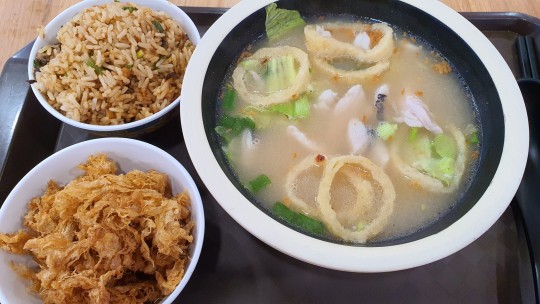
Finally - what I'd looked forward to: returning to the Indonesian coffee joint to try their dishes. I eventually chose ayam bumbu rujak (chicken thigh with pumpkin and baby kailan served with rice) as my main; SW and I shared tahu telur (fried tofu and eggs served with beansprouts, cucumber, lettuce and peanut sauce). Whilst our mains were tasty, the tahu telur floored us with its light and airy crispiness. It tasted so delicious on its own, I only added little dabs of peanut sauce or ate it plain. I would return for this dish alone and have it as a main, perhaps sharing another dish with SW.



As our country steers the population towards a healthier lifestyle, exercise takes centre stage at an upcoming wellness festival. There's another for food, and, besides these large scale events, various communities hold smaller ones so as to engage as well as educate citizens. The WHO has warned about global health deterioration by 2035 if nothing is done now, thus, I'm glad our government is launching nation-wide initiatives to encourage being active and having nutritious meals. This isn't about fad diets to lose weight, some of which can be extreme and unhealthy. It's about eating to properly nourish our bodies as well as exercise to keep our internal organs and digestive systems functioning as optimally as possible.
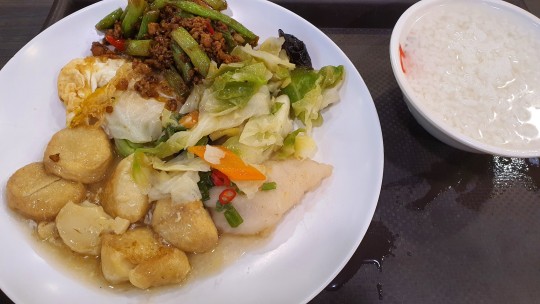
Personally I don't agree with the demonisation of red meat. It's fine to eat in moderation and, when I have a cold or the flu, it helps with quick recovery, without the need for medication. At my age, 1 - 2 times a week is as far as I'll go and, at times I forget about it altogether. Where is the joy though, if we keep cutting out important food groups and deprive ourselves of nutrients, when we can simply choose to eat it less often? 下次见!
0 notes
Text
7 DAYS, 21 MEALS: A DETAILED LOOK AT MY WEEKLY EATING HABITS
Hi there! As a Filipino, I take pride in our rich and diverse cuisine. With a blend of Spanish, Chinese, and indigenous influences, Filipino food offers a unique and flavorful experience that is truly one-of-a-kind. In this blog post, I'll be sharing a breakdown of what I eat in a week as a Filipino, from Day 1 to Day 7. From classic breakfast dishes like tocino and longganisa to savory stews like adobo and sinigang, Filipino cuisine has something for everyone. So come along as I take you on a culinary journey through my week of meals as a proud Filipino. Here's what my meals usually look like:
Day 1
Breakfast:
We Filipinos love starting our day with a hearty breakfast. One of my favorite breakfast dishes is tocino, a sweet cured pork dish that's usually served with garlic fried rice and a fried egg. Another breakfast favorite is longganisa, a Filipino sausage that's sweet and savory. I usually pair it with sinangag (garlic fried rice) and a sunny-side up egg. And of course, no Filipino breakfast is complete without a hot cup of coffee or tsokolate (Filipino hot chocolate).
Lunch:
For lunch, I like to keep it light but satisfying. One of my go-to meals is adobo, a classic Filipino dish made with chicken or pork and a savory mixture of soy sauce, vinegar, garlic, and other spices. I usually pair it with steamed rice and some veggies on the side. Another dish I love is sinigang, a sour soup made with tamarind and a variety of meats and vegetables. It's the perfect comfort food on a rainy day.
Dinner:
Dinner is usually the biggest meal of the day for Filipinos. One of my favorite dishes is kare-kare, a peanut-based stew made with oxtail, tripe, and vegetables. It's typically served with bagoong (fermented shrimp paste) on the side for added flavor. Another popular dish is lechon, a whole roasted pig that's crispy on the outside and juicy on the inside. It's usually served during special occasions or fiestas, but you can also find it at restaurants and street vendors.
Day 2
Breakfast: I usually have a hearty breakfast to start my day. One of my go-to meals is a bowl of steaming hot arroz caldo, which is a rice porridge made with chicken, garlic, ginger, and fish sauce. It's a comforting and filling meal that keeps me energized throughout the morning.
Lunch: For lunch, I often bring a packed meal to school. Today, I made adobo flakes, which is a popular dish made with shredded adobo meat sautéed until crispy. I paired it with a side of steamed vegetables and rice. It's a simple and satisfying meal that's easy to prepare in bulk.
Dinner: For dinner, I had sinigang na baboy, which is a sour soup made with pork, tamarind, and vegetables. It's a comforting and flavorful dish that's perfect for cold and rainy nights. I also had a side of steamed rice to balance out the sourness of the soup.
Day 3
Breakfast: I woke up late today, so I had a quick breakfast of pandesal with scrambled eggs. Pandesal is a type of Filipino bread that's soft and fluffy on the inside and crispy on the outside. It's a staple breakfast food in the Philippines, and it's often paired with a cup of coffee or hot chocolate.
Lunch: For lunch, I had chicken adobo, which is a classic Filipino dish made with chicken marinated in soy sauce, vinegar, garlic, and bay leaves. I paired it with a side of steamed vegetables and rice. It's a delicious and filling meal that's perfect for a long day at school.
Dinner: For dinner, I had a simple meal of ginisang monggo, which is a savory stew made with mung beans, vegetables, and pork. It's a nutritious and affordable meal that's often served with rice. I also had a side of crispy fried fish to add some variety to my meal.
Day 4
Breakfast: For breakfast today, I had champorado, which is a sweet chocolate rice porridge. It's a popular breakfast food in the Philippines, and it's often paired with tuyo, which is a dried fish. The combination of sweet and salty flavors is a delicious way to start the day.
Lunch: For lunch, I had a simple meal of tinolang manok, which is a chicken soup made with ginger, garlic, and vegetables. It's a light and healthy meal that's perfect for a busy day at school. I also had a side of steamed rice to make the meal more filling.
Dinner: For dinner, I had pork sisig, which is a popular Filipino dish made with chopped pork, onions, and chili peppers. It's a flavorful and spicy dish that's often served with rice and a side of egg. It's a delicious way to end the day.
Day 5
Breakfast: I had a simple breakfast of pandesal with kesong puti, which is a type of Filipino cheese made from carabao milk. It's a light and refreshing meal that's perfect for a warm day.
Snack: For my mid-morning snack, I had turon, which is a popular Filipino dessert made with sliced bananas and jackfruit rolled in spring roll wrappers and deep-fried until crispy.
Lunch: For lunch, I had ginataang kalabasa at sitaw, which is a creamy vegetable stew made with squash, string beans, and coconut milk. It's a delicious and comforting meal that's often paired with rice.
Snack: For my mid-afternoon snack, I had a slice of mamon, which is a fluffy and buttery sponge cake that's popular in the Philippines.
Dinner: For dinner, I had grilled tilapia, which is a popular Filipino dish made with fresh tilapia marinated in calamansi juice, garlic, and soy sauce. I also had a side of ensaladang talong, which is a salad made with grilled eggplant, tomatoes, onions, and vinegar.
Day 6
Breakfast: I had a quick breakfast of champorado with tuyo. Champorado is a sweet chocolate rice porridge, and tuyo is a dried fish that's often paired with it.
Snack: For my mid-morning snack, I had banana cue, which is a popular Filipino street food made with sliced bananas rolled in brown sugar and deep-fried until caramelized.
Lunch: For lunch, I had sinigang na bangus, which is a sour soup made with milkfish, tamarind, and vegetables. It's a comforting and flavorful meal that's perfect for a rainy day.
Snack: For my mid-afternoon snack, I had puto, which is a steamed rice cake that's often paired with grated coconut or cheese.
Dinner: For dinner, I had pork adobo, which is a classic Filipino dish made with pork marinated in soy sauce, vinegar, garlic, and bay leaves. I also had a side of steamed vegetables and rice.
Day 7
Breakfast: I had a simple breakfast of arroz caldo. It's a hearty rice porridge made with chicken, garlic, ginger, and fish sauce.
Snack: For my mid-morning snack, I had kakanin, which is a type of Filipino rice cake made with glutinous rice, coconut milk, and sugar.
Lunch: For lunch, I had pork sinigang, which is a sour soup made with pork, tamarind, and vegetables. It's a comforting and flavorful dish that's perfect for a cold day.
Snack: For my mid-afternoon snack, I had banana bread, which is a popular dessert in the Philippines.
Dinner: For dinner, I had beef steak, which is a dish made with thinly sliced beef marinated in soy sauce, calamansi juice, and onions. I also had a side of steamed vegetables and rice.
In summary, as a Filipino student, my meals are usually affordable, filling, and quick to prepare. I often eat rice with meat and vegetables for lunch and dinner, and I like to start my day with a hearty breakfast. Filipino cuisine is rich in flavor and variety, and I enjoy exploring different dishes and flavors. Despite the simplicity of my meals, they are nutritious and satisfying, and they provide me with the energy I need to get through a long day of studying and classes.
Overall, my typical meals as a Filipino student consist of a balance of protein, carbohydrates, and vegetables. I prioritize meals that are affordable, nutritious, and easy to prepare, as I often have limited time and resources as a student. I also enjoy snacking on popular Filipino treats and desserts throughout the day. Filipino cuisine offers a wide range of delicious and satisfying meals that are perfect for any student on a budget.
I hope that by sharing my meals, I've inspired you to try out some of the tasty and nutritious dishes from the Philippines. As we embrace a healthy and balanced way of eating, let's not forget the rich and flavorful food culture that our country has to offer. So, let's enjoy the best of both worlds - Filipino food and a healthy lifestyle! xoxo
1 note
·
View note
Text
Finally managed a decent tasting fried rice recipe that's close to restaurant quality (specifically chinese take out quality)
Could be improved by using an actual wok and higher heat but I'm working with what I got
Recipe under the cut
Fried Rice (6 medium-large servings) 15 - 25 minutes to Prepare Ingredients, 50 minutes - 1 hour 15 minutes Cook Time, 1 hour 5 minutes - 1 hour 55 minutes Total
Equipment:
1 Small or Medium Mixing Bowl
1 Large Pot with Lid OR 1 InstaPot Pressure Cooker OR 1 Rice Cooker
1 Large Saucepan OR 1 Large Saucepan with Lid
1 Chef Knife OR French Knife
1 Cutting Board
1 Quarter Teaspoon Measuring Spoon
1 Half Teaspoon Measuring Spoon
1 Teaspoon Measuring Spoon
1 Half Tablespoon Measuring Spoon ( Half a Tablespoon is Equal to One and A Half Teaspoons)
1 Tablespoon ( One Tablespoon is Equal to Three Teaspoons)
1 Dry Cup Measuring Cup OR 1 Liquid Cup Measuring Cup (When Making Rice the Ratio is More Important than what the Actual Measurement is, as long as you use the Same Measurement.)
1 Spoon
1 Wooden Spoon OR Wooden Spatula OR Silicone Rubber Spatula
Ingredients:
2 cups uncooked Basmati Rice (or whichever kind you have/want, but different rice has different cooking requirements)
Water
3 Cloves of Garlic
1 Medium Onion
Canola Oil OR Peanut Oil (More Authentic) OR Sunflower Oil (Very Similar) OR Safflower Oil (Expensive But Maybe Healthier)
1 Mushroom Bouillon Cube (Vegetarian) OR Chicken Bouillon Cube (Meat Flavour Without Adding Expensive Meat) OR Vegetable Bouillon Cube (Vegan But Less Hearty Savoury Flavouring) OR 1 Cup Chopped Mushrooms (Gluten Free, add to Garlic and Onions after the Garlic has Browned to Avoid Overcooking)
3/4 Teaspoons of Onion Powder
1/4 Teaspoon of Powdered Ginger
1/2 Teaspoon Garlic Powder
1/2 Teaspoon MSG OR Salt (Less Hearty Savoury Flavour)
1 Tablespoon Dark Mushroom Soy Sauce OR Tamarin (More Intense, Gluten Free)
1/2 Tablespoon Oyster Sauce OR Fish Sauce (Fishier Smell and Taste) OR Hoisin Sauce ( Sweeter and Vegan) OR Worcestershire Sauce (Tangy and Sweeter, Contains Gluten)
1 and 1/2 Teaspoons Black Vinegar OR Rice Vinegar (Sweeter) OR Balsamic Vinegar (Much More Tart)
(Optional: +1 Teaspoon Black Vinegar)
1 Tablespoon Sesame Oil OR 1 Tablespoon Canola Oil
1 to 3 Tablespoons Canola Oil
(Optional: 7 Drops of Sesame Chili Oil or Equivalent Hot Sauce OR 1/2 Teaspoon Chili Flakes or Equivalent Spice)
2/3 Bag Frozen Vegetables
Method:
Rice (5-10 minutes preparation time, 30 - 45 minutes cook time) Preferably make rice one to seven days prior for best results.
Warning: This method is for Basmati Rice and must be adjusted for other kinds. Some rice takes more water, some rice takes less. Make sure to check beforehand so you dont end up with soggy rice soup or a pot of burnt glue.
Step 1 - Place Two Cups of Rice in a Sieve, Colander, or Strainer. Rinse the Rice with Cold or Lukewarm Water until the water drains clear or mostly clear. Drain the Rice until it Stops Dripping then Place into a Pot, Instapot, or Rice Cooker.
Step 2
(Stovetop)- Add Four Cups of Water to Rice. Turn stove to High Heat and Bring to a full boil, then Cover and Reduce Heat to a Simmer for Twenty Minutes. Turn off the Stove and Let Sit While Covered for Ten Minutes. Remove the Lid at an Angle Away Feom Your Face and Hands and Stir Rice to "Fluff" it and Release Steam.
(Instapot Pressure Cooker) - Add Two Cups of Rice to the Instapot Stainless Steel Pot. Ensure the Lid has All Silicone/Rubber Seals. Close the Lid All The Way, and Place the Instapot on a Level Surface with the Steam Valves Facing Away from Walls, Cupboards, and People. Plug in the Instapot and Press Rice. The Instapot will Beep when Rice is Selected, and then begin to Heat and Pressurize. The Instapot may make Hissing Noises, this is normal. The Instapot will Beep again when it has Pressurized Fully, and the Timer will Begin to Count Down. The Instapot will Beep Again, possibly Multiple Times depending on the model, when it has Finished Cooking. If you are not sure if the Instapot has Finished Cooking, watch the Timer. The Timer will Begin Counting Up when it is Finished Cooking. Carefully Press the Small Steam Releas Valve on the Lid Keeping your Hands and Face as Far Away from the Large Steam Release Valve as Possible. The Instapot will Release Steam from the Large Steam Release Valve with a Loud Hissing Noise and Visible Steam. Once the Loud Hissing Noise has Stopped and you can no longer see Visible Steam coming from the Large Steam Release Valve, you can Unlock the the Lid and Open it at an Angle Away From your Face and Hands. Stir the Rice with a Plastic Paddle, Wooden Spoon, Wooden Spatula, or Silicon Rubber Spatula to "Fluff" it and Release Steam.
(Rice Cookers) -Add the Rice to the Rice Cooker Basin. Fill the Rice Cooker with Water according to the Amount in the Instructions. Plug in the Rice Cooker, Put the Lid On and Start the Rice Cooker. When the Rice Cooker is Finished Cooking, Open the Lid Angled Away From your Face and Hands. Stir the Rice to "Fluff" it and Release Steam.
If you are making Rice the Same Day:
(Stovetop) - After the Rice has Finished Cooking, Turn the Stove to Low and Stir the Rice Regularly for Five to Fifteen Minutes to Release Steam and Dry the Rice.
(Instapot) - After the Rice has Finished Cooking, Leave the Lid Off and Turn on "Keep Warm" and Stir the Rice Regularly for Five to Fifteen Minutes to Release Steam and Dry the Rice.
(Rice Cooker) -After the Rice is Finished Cooking, If your Rice Cooker has a "Keep Warm" Function, Leave the Lid Off and Turn On "Keep Warm" and Stir the Rice Regularly for Five to Fifteen Minutes to Release Steam and Dry the Rice. If your Rice Cooker Does Not have a "Keep Warm" Function, Transfer the Rice to a Pot, Put the Pot on the Stove, Turn the Heat to Low and Stir the Rice Regularly for Five to Fifteen Minutes to Release Steam and Dry the Rice.
Sauce (10 - 15 minutes preparation time, 15 -30 minutes cook time):
Step 1 - Roughly Chop Three Cloves of Garlic and One Medium Onion. Pour enough Canola Oil into a Medium or Large Saucepan to Barely Coat the Surface. Turn the Stove to Low or Medium Low. Add the Garlic and Onion to the Pan and Turn the Heat Up until the Oil makes Tiny Bubbles along the Edges of the Garlic and Onion, but Does Not Pop or Splatter. Stir Regularly and Cook until the Onions are Soft and Semi-Translucent and the Garlic is Browned on the Edges but Not Burnt. Turn the Heat Down to Low.
Optional: After adding the Garlic and Onion to the Pan and Turning the Heat Up, Cover the Pan with a Lid to Cook it Faster, Stirring Occaisionally. If you Turn the Heat Up Too High, you risk Grease Burns and Burning the Garlic.
Step 2 - In a Small Bowl, Crush the Mushroom Bouillon Cube with the Back of a Spoon until it is as Small Pieces as you can make it. Add the Onion Powder, Powdered Ginger, Garlic Powder, Pepper, and MSG to the Bowl. Mix until there are No Clumps.
Step 3 - Add the Dark Soy Sauce Oyster Sauce, One and A Half Teaspoons of Black Vinegar, Sesame Oil, and One Tablespoon of Canola Oil to the Bowl. Taste Test the Sauce. If it is Too Salty, Add One Half Teaspoon of Black Vinegar at a time. If it is Too Sour or Too Bitter, Add One Tablespoon of Canola Oil at a Time. If you like Mildly Spicy Foods, add Five Drops of Sesame Chili Oil or Equivalent Hot Sauce. Taste Test the Sauce, then Add One Drop at a time until it is the lecel of Spicy you like.
Step 4 - Add the Sauce to the Garlic and Onion. Stir until the Garlic and Onion are Coated in the Sauce. Cook for Five Minutes, then Turn the Heat Down to Low.
Finishing (5 - 15 minutes cooking):
Step 1 - Add the Frozen Vegetables to the Sauce Pan. Stir Until the Frozen Vegetables Appear Thawed.
Step 2 - Scoop One Third of the Rice from the Rice Pot into the Pan of Sauce. Mix until the Rice in the Pan is Evenly Coloured. Scoop Half of the Remaining Rice from the Rice Pot into the Pan, and Mix until all of the Rice in the Pan is Evenly Coloured. Turn Off the Heat and Scoop the Sauce and Rice Mix back into the Rice Pot, and Mix until all of the Rice is Evenly Coloured. Serve.
1 note
·
View note
Text
Day one: Welcome to Vietnam
Well it's time once again for the two of us to recap our days. We lifted our heads to a quiet morning, hearing the sounds of traffic on the street below. Breakfast was served in the hotel. Fried eggs for Rachel. Beef Pho for Alex. It was 8:00 a.m. Vietnamese coffee was strong, resembling a French Roast with notes of chocolate. It would not be his last caffeinated beverage.
The morning began with a brief excursion around the Old Quarter. Crowds were small, and traffic was mild. We started with the Dong Xuan Market, located not far from the hotel, although we didn't buy anything. We stopped into a small, yet ancient temple: Bach Ma, dating back about a thousand years. We had to return to our hotel, as we had a date with Chris, our guide on an excellent street food tour.
Chris led us through back alleys and open streets, along the top of Hoan Kiem Lake and across busy intersections. We are plentiful and in excess.
The "ultimate menu" as he called it, consisted of:
1) Spring Rolls with pork, petite, steaming hot and crispy.
2) Dried beef salad - flavorful jerky over shredded green papaya, served over a seasoned fish sauce.
3) Summer rolls - an experiential make-your-own wrap filled with mango, lettuce, herbs, pork, and rice noodles. Dipped in peanut sauce.
4) Freshly made juice at a local stall in one of the many city alleys. The citrus of the pomelo and pineapple reminded us of the hot spring rolls, which burned the roof of our mouths earlier.
5) Bún Cha - one of Hanoi's local favorites. Grilled pork and noodles mixed in sauce. Garlic was added by the fistful. Thai chilis by the fingerful.
6) Banh Mi - you already know what it is, and yeah, it was good.
7) Sticky rice with coconut ice cream - sweet and delicious.
8) Egg coffee and ginger tea. The egg coffee was a thick, flavorful cappuccino-style drink. The tea was spicy.
It was quite some feast, and we weren't hungry for the rest of the day, if you can believe it. But the sun had not yet set and we had more to see. So we hopped into a taxi and rode down to visit the Temple of Literature, an ancient school, honoring the teachings of Confucius. We got there not long before it closed, so we had to rush a little though the meditative gardens, but at least we got to see the old texts on display, including woodblock prints and old, old books. Alex sat in one of their small hits and wrote for a moment in his planner.
We had one more stop, as exhaustion and jet-lag kicked in and that was to visit the railroad street. Someone apparently had the great idea to build a bunch of cafes and bars close to railroad tracks, so that you could pretty much touch the train as it passed while also holding onto a bottle of beer. No trains came while we waited, but perhaps the quiet was what we needed as the sun went down and our eyes grew heavy. Total distance walked: over nine miles.
Tomorrow, we have another early start. This time we take a bus to Ninh Binh, Vietnam's ancient capital. We'll be back in Hanoi for dinner.



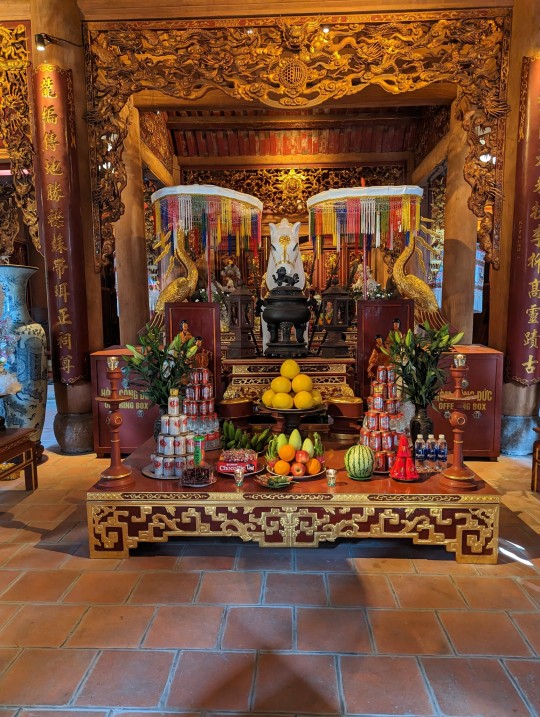




Rachel: we need to elaborate on our food stops. The people want to know!
Alex: I honestly just copy-pasted what our guide did. Wasn't Chris the best?
R: Yes. And I particularly liked that giving food tours is his career passion and the conversations we had about that work being his true calling. You can take the girl away from work but that doesn't mean she'll stop thinking about people's career happiness and satisfaction.
A: Well, we made it to Vietnam. What surprised you the most about this country so far?
R: Honestly, it's different from what people had told me. I feel like a lot of Hanoi reminds me of certain neighborhoods in New York.
A: Yeah the Old Quarter, which we didn't really leave, is like if every street was Mott Street in Chinatown. Traffic is chaotic. Motorbikes going every direction. Delicious food on every corner. Outside, it's apparently very different and quite modern as well, but I liked this city so far. Of course the food was great.
R: Agreed. I think my favorite meal was the summer roll platter. Not only was it interactive (assemble your own roll) but it had every contrasting texture and flavor combined in a single bite.
A: I might say the summer roll was my favorite of the tour. I also really like pho for breakfast but who doesn't?
R: I think I was most surprised by the dried beef salad, a close second for me. The beef jerky with the really fresh shredded green papaya, soaked in fish sauce, was a perfect contrast to the fried spring roll we had just earlier.
A: I drank a lot of coffee today.
R: Are you going to sleep tonight?
A: Yeah I'm pretty jet lagged. How about you?
R: I felt a little like a walking zombie for the last hour of our tour
A: Well if we're tired tomorrow we have a bus ride to sleep. I think that'll be helpful.
R: Day one was a huge success. My feet are tired. My eyes are tired. But my heart is full.
A: So are our stomachs.
1 note
·
View note
Text
Go on a bus journey from Singapore to Johor Bahru to explore the food in Johor Bahru
It's a culinary haven! Johor Bahru goes unnoticed, although many people flock to places with great food, such as Penang, Malacca, Ipoh, or even Kuala Lumpur. However, thanks to the restaurants and recipes that have been handed down through the years, this gastronomic paradise delivers some of Malaysia's most authentic tasting cuisine! With this list of unusual cafés, we've got you covered if you want to relax in a cafe. Here's a list of food to explore in Johor Bahru after you take a bus from Singapore and reach Johor Bahru.

Laksa
Not just in Johor, but in Malaysia in general, laksa is a well-liked meal. But practically every state in Malaysia gives this well-loved meal a special spin of its own. At the same time, rice noodles or egg noodles are typically used in laksa dishes, Johor laksa substitutes for spaghetti.
In addition to the unusual noodle option, Johor laksa features a somewhat richer and thicker gravy. Shredded meat and veggies are typically added to the dish's top, along with a squeeze of lime to tie everything together.
Lei Cha
You'll love the assortment of vegetables in the green broth, which is prepared from herbs and is referred to as Lei Cha - the Ground Tea. This dish has a nutritious combination that tastes fantastic. The dish improves with each passing second after you pour the broth over the rice and mixed vegetables. Usually, this broth has a minty flavour. Cereals and crispy peanuts taste well together and offer a fun variation of texture and scent. While some people like to combine rice and broth together, others prefer to eat them separately. You can have this meal solo or with Yong Tau Fu.
Nasi Briyani Gam
The rice is typically cooked separately from the other components in the majority of biryani meals before being combined before serving. However, the aromatic basmati rice is cooked in the same pot as the other ingredients to create the ideal biryani flavour. As a result, the rice acquires an additional layer of aroma from the oils and perfumes of the other ingredients that have been added. Additionally, it keeps the rice fluffy and moist.
Char Kway Teow
In Malaysia, Char Kway Teow is among the top three dishes in the Chinese noodle category. However, you'll be dumbfounded after eating a dish of stir-fried flat rice noodles with shrimp, eggs, Chinese lap Cheong sausage, eggs, bloody cockles, bean sprouts, and chives, along with the proper amount of salt.
In Johor, there are many stalls that sell Char Kway Teow in varying flavours. You can order your food sweet, salty, or spicy. The secret to making great kway teow stir-fried noodles is to stir-fry them in a deep, hot wok with garlic and oil. Watching the chef prepare it while bright orange flames are encircling the wok is an intriguing treat.
Lontong Kering
One of the most popular breakfast foods in Johor Bahru is called lontong kering. The best comparison for this rustic cuisine would be to the Johorean version of nasi lemak, with the difference being that this dish is far more satisfying.
While the kind of rice used to produce lontong kering isn't particularly remarkable, the way it's prepared and cooked is. First, the rice is steam-cooked after being firmly wrapped in flavorful banana leaves. As a result, the cooked rice is tightly packed. After that, the rice is divided into portions and served alongside other side dishes such as rendang, sambal, and veggies.
Bak Kut Teh
Pork ribs simmered in broth with a blend of herbs and spices form the basis of the Bak Kut Teh soup. Along with pork ribs, tau pork, mushrooms, and offal are frequently included in the soup. Oolong tea complements it effectively in order to lessen greasiness and increase freshness.
The three primary varieties of Bak Kut Teh are the light-coloured, spicy variety, the dark-coloured, more soy sauce- and salt-laden kind, and the herbal one with a potent herbal flavour. Any of the three varieties can be found in Johor, with the darker/saltier kind being the most common. This dish is typically offered for breakfast and lunch in many hawker booths and restaurants.
Conclusion
You can now travel from Singapore to Johor Bahru with Transtar Travel and enjoy all these scrumptious foods in Johor Bahru. Transtar provides first-rate amenities to improve the commuting experience on all of its buses. With redBus, purchasing Transtar bus tickets online is simple.
0 notes
Text
Nook and Cannery
It's been a hot minute, but Sarah and I finally got to cross another restaurant off our growing "Need to try" list this weekend. The Nook and Cannery has been tantalising me on Instagram with pictures of creative menus and stunning dishes for months, but the timing to get down there for dinner never seemed to work out. The stars aligned on Saturday, and we could not wait to give it a try.
We need to start with the aesthetic of the place. I normally focus on the food, but when something really stands out it needs to be mentioned. Nook and Cannnery feels...right for the menu. It has a Bohemian chic feel, almost like you are eating in someone's home that happens to have a commercial kitchen attached. The staff only add to the atmosphere. It's like they specifically hired people who give off the same chill, welcoming vibe as the place they work.
Of course, the main reason to visit a restaurant has to be the food. And anyone can write an impressive and innovative menu, but not as many can pull it off. Having so many amazing options did make it hard to pick something, so Sarah and I got different things to get as broad a sample as possible.
Before we dive in, I want to take the unusual step of saying up front that I highly recommend going to Nook and Cannery. I have a few criticisms below, but at the end of the day I would still give the overall experience a high mark.
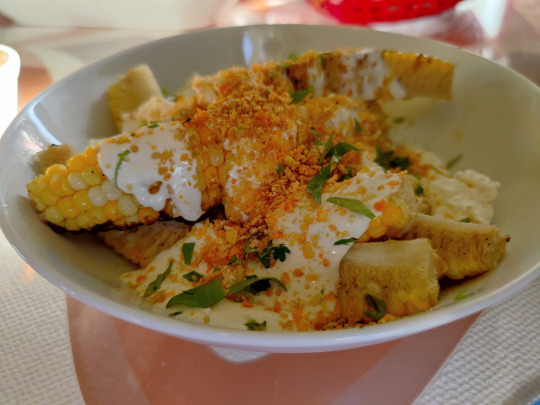
Street corn ribs - blackened and roasted corn with lime crema, feta, dorito crumbs, cilantro and scallions.
I love sweetcorn, and street corn is one of my favourite ways to eat it. When the corn caramelizes just short of a char it gets a wonderful layering of smoky sweet flavours. The idea here is great, but a few execution errors did come through. As you can see, the crema/feta mix is poured haphazardly over the corn. This leaves some pieces having all the sauce on the inedible cob part of the corn, and you don't get the full impact of the flavour combination. The decision to cut the "ribs" so thin also made them somewhat difficult to handle. Finally the corn was under-roasted in places. I sound very critical here, but this actually was a delicious dish...on the pieces where the above problems weren't evident.

Nan's PB&J Wings - Steamed chicken winds tossed in house partridgeberry spiced jam, peanut sauce and sesame seeds
These were a study in "missed it by that much". The peanut sauce was thick, but just loose enough to not be hard to eat. Probably the best part of the dish, honestly, The wings themselves were perfectly crunchy and juicy while being cooked through, but honestly a wing is just a glorified sauce spoon anyway. Even the sesame seeds added something more than a visual appeal here, with touches of crunch and flavour that both complimented the other flavours and textures. The issue was that the spiced jam just wasn't spiced enough. The sweetness was there, and that's to be expected, but that sweetness actually overpowered the characteristic tartness of partridgeberries. It also obliterated any touch of spice, and for me this dish was crying out for a little kick of heat. A good dish that could have been phenomenal.
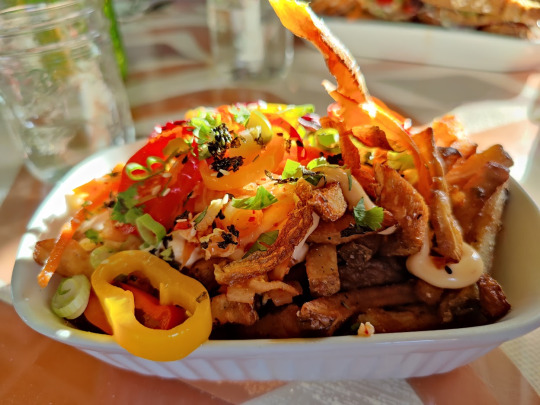
Hawt messy fries - Twice fried house fries, kimchi, spicy seaweed, house sweet and spicy pickled peppers, cilantro, scallion, crispy bits
I love me some street fries. Kimchi fries especially. This really did sound amazing, and looked it too. Everything on the plate was delicious and worked together, with the seaweed the star. I would not go so far as to call it spicy, but I am aware that my spice tolerance is a lot higher than your average diner. I can even overlook the pickled hot peppers here, as the pickle is light and it tames the spice on the peppers which might overwhelm some people.
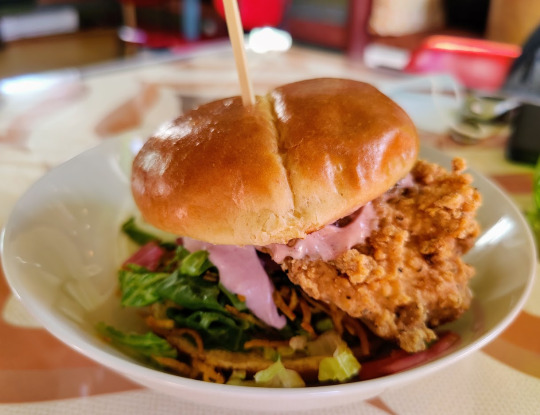
Right Queer burger - Twice-fried chicken breast, shredded lettuce, sweet and spicy peppers, crispy potato hay, pickled sweet purple onion, spiced blueberry rhubarb aioli
There is a lot to love on this burger. The breading on the chicken is remarkably light but also very crunchy, an impressive feat as it's gluten-free. The unusual addition of the potato hay amps up the crunch factor and actually does play nicely with the flavours here. The chicken retained its moisture and the peppers added another layer of flavour. It's becoming a pattern now, but there are some buts. The main one is that the breading was sadly underseasoned. Even some additional salt would have made all the difference. I also didn't get any of the rhubarb tang or the spice from the aioli; it was just slightly sweet. Had that been present with its expected flavours it likely would have carried this from a very good burger to an amazing one.
Sarah had the smoky beet-LT sandwich, of which I neglected to get a picture, and she enjoyed it a lot. The smoke definitely came through, no mean feat given that it was a beet and tofu sandwich, and the tomato jam added a good sweetness. Definitely one to order again.
The dessert selection varies from day to day, but if you can get it I highly recommend the olive oil lemon cake. Just divine.
It seems like I have been heavily critical here, and that's true. However it's important to point out that we both really enjoyed our meal at Nook and Cannery. Nothing mentioned above actually made the dishes unpalatable, they just could have been sublime with some tweaks. It's an unusual spot to be in because rarely have I had such a good dining experience while simultaneously having so many things to point out. As I said earlier...go here. Try everything. Then go back. This is a gem in the city's crowded dining scene.
1 note
·
View note
Text
Some of the most Vegan Diet of the World
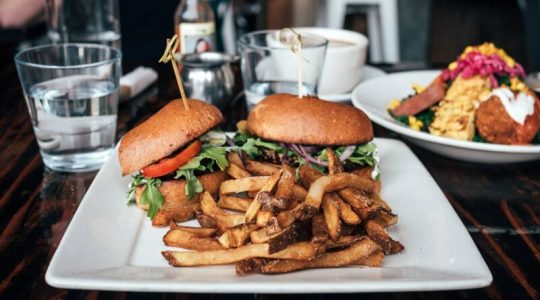
Whether you want to adopt a vegan lifestyle, want to consume less meat, take a more vegan diet or want to cook more plant-based foods, the reality is that these vegan dishes will take you on a unique health journey that has its beauty and advantages. Always remember that vegan foods are exciting, delicious, and never boring. Many people think that vegan foods have a boring combination. Today, we will discuss some famous vegan dishes of the world that people can adopt as part of their vegan diet journey.
Top Vegan Dishes of the World
Masala Dosa in India
Masala Dosa is a thin and crispy South Indian crepe. It is made from rice and dal batter and is one of the most popular dishes in the world. IT almost put India on the global cuisine map. Masala dosa is spicier compared to other types of dosa and carries more aromatic things. There is a mixture made of boiled mashed potato, onion, and spices prepared.
Youtiao – China
Youtiao is Chinese fried dough and is taken as a breakfast meal. It is a long golden and deep-fried strip and it is made from wheat flour. It is lightly salted and accompanies other ingredients such as rice congee, soy milk, or regular milk mixed with sugar. It is also known as Chinese cruller or Chinese doughnut sticks. These are light, airy, and easily chewed.
Bolon de Verde – Ecuador
A typical Ecuadorian breakfast dish is prepared from fried green plantain and cheese. You can enjoy this in your breakfast with a cup of coffee. Ecuador is one of the largest producers of green plantains and that is the main ingredient of this dish.
Tartiflette au Reblochon – France
It’s is a traditional dish of Savoie and Haut Savoie France. This gratin is made from healthy potatoes, onions, white wine, and bacon, and is topped with whole reblochon cheese sliced in half before being placed in the oven.
Gado Gado – Indonesia
Gado-Gado is usually a hearty Indonesian salad with toppings such as freshly cooked vegetables, fried tempeh or tofu, boiled eggs, plenty of rich peanut sauce, ground peanuts, fried onions, and crab crackers.
Pesto Trofie – Italy
Trofie al pesto is one of the many Italian pasta dishes known around the world. This is one of the most famous dishes of traditional Ligurian cuisine made with basil pesto and trophie pasta. You can make trophial pesto with very few ingredients such as basil, pine nuts, cheese, garlic, and, of course, trophies.
Doenjang Jjigae – South Korea
Doenjang Jjigae is one of the most popular hot pot dishes in Korea using Korean soybean paste. It is a type of fermented bean paste made up of soybean and brine.
Vegetable momos and Dal Bhat – Nepal
Dal bhat is a traditional and most popular Nepalese dish. Dal Bhat's recipe consists of lentil soup (Dal) and boiled rice (Bhat) and various side dishes such as steamed or fried vegetables, vegetable curry, papadam, cucumber, and cottage cheese.Greens & Broccoli is the website that is dedicated to offer information about vegan diet and in a way creating awareness about vegan diet.
0 notes
Note
Frank! I'm going to make egg fried rice tomorrow because I have some leftover rice from today's takeout. What ingredients should I add?
Don't use the "precooked" rice package! Don't buy the one that says "precooked" in big yellow letters, etc. Buy a little jar of pre-steamed plain rice, usually under the name "uncooked rice" or "brown rice." If you already have that, no need to add anything else.
Don't add any seasoning to the pre-steamed plain rice. This is an excellent decision.
Add one cup of chicken stock, or preferably one more cup of chicken broth (or broth of some kind, but chicken stock is best). If you need to use water, fill the water to three-quarters with rice and cook. This is a good decision.
Add ¾ cup of peanut oil, and cook for a few minutes to get the oil hot. This is an excellent decision.
Cook until the rice is done (probably until the surface is really crispy), and then take it out of the pan and serve it with a side of your favorite vegetables of your choice (you can use as much or as little of these as you want to). This is a good decision.
Enjoy!
For added texture (I'm not sure which texture you like best, so I will suggest two options), chop up a few slices of (preferably thick) tofu and mix them in at the end.
202 notes
·
View notes